Cultural Safety Action Plan: University Nursing Program, Semester 1
VerifiedAdded on 2023/03/17
|9
|2035
|28
Report
AI Summary
This report details a cultural safety action plan developed to enhance nursing practice and improve patient outcomes. The plan outlines specific goals, such as applying cultural safety principles during care delivery and interactions, and objectives, including acquiring skills for cultural competence and sensitivity. It identifies necessary resources and training, including continuing education programs and interpreter services workshops. The report anticipates barriers like high workloads, lack of interpreter services, and language proficiency challenges. It proposes strategies to overcome these, such as time management, advocating for interpreter services, and collaborating with interpreters. The evaluation method involves patient satisfaction surveys and reflection on interpreter service effectiveness. The rationale underscores the importance of cultural safety in reducing disparities, preventing cultural value violations, and promoting patient-centered care. The implementation strategy involves continuous professional development, online resources, and communication with hospital administrators. The report highlights the use of interpreter services to address language barriers and evaluates progress through checklists, mentor feedback, and patient feedback. The plan aims to initiate interpreter services and ensure their appropriate use to improve patient care.

Running head: CULTURAL SAFETY
Cultural safety
Name of the student:
Name of the University:
Author’s note
Cultural safety
Name of the student:
Name of the University:
Author’s note
Paraphrase This Document
Need a fresh take? Get an instant paraphrase of this document with our AI Paraphraser
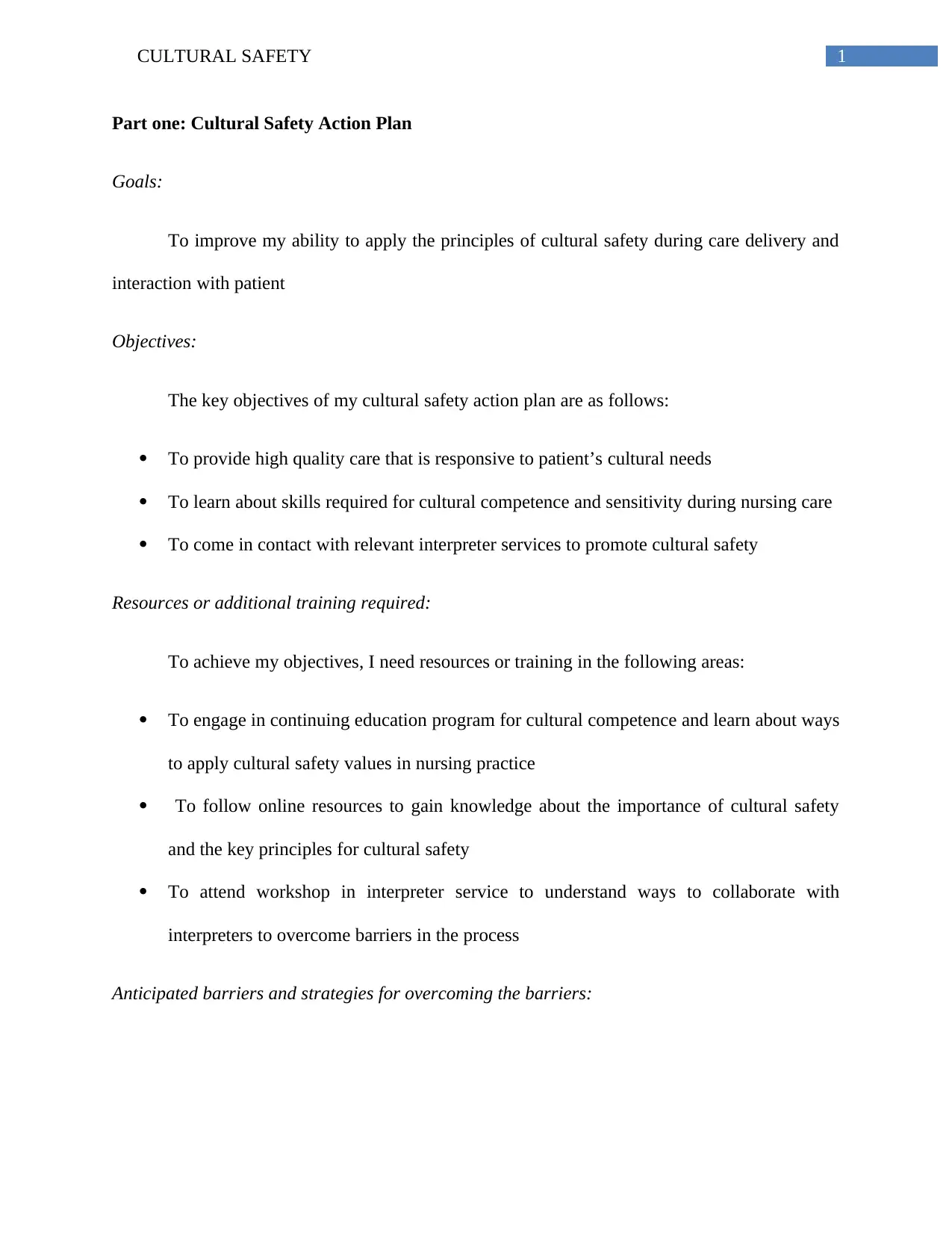
1CULTURAL SAFETY
Part one: Cultural Safety Action Plan
Goals:
To improve my ability to apply the principles of cultural safety during care delivery and
interaction with patient
Objectives:
The key objectives of my cultural safety action plan are as follows:
To provide high quality care that is responsive to patient’s cultural needs
To learn about skills required for cultural competence and sensitivity during nursing care
To come in contact with relevant interpreter services to promote cultural safety
Resources or additional training required:
To achieve my objectives, I need resources or training in the following areas:
To engage in continuing education program for cultural competence and learn about ways
to apply cultural safety values in nursing practice
To follow online resources to gain knowledge about the importance of cultural safety
and the key principles for cultural safety
To attend workshop in interpreter service to understand ways to collaborate with
interpreters to overcome barriers in the process
Anticipated barriers and strategies for overcoming the barriers:
Part one: Cultural Safety Action Plan
Goals:
To improve my ability to apply the principles of cultural safety during care delivery and
interaction with patient
Objectives:
The key objectives of my cultural safety action plan are as follows:
To provide high quality care that is responsive to patient’s cultural needs
To learn about skills required for cultural competence and sensitivity during nursing care
To come in contact with relevant interpreter services to promote cultural safety
Resources or additional training required:
To achieve my objectives, I need resources or training in the following areas:
To engage in continuing education program for cultural competence and learn about ways
to apply cultural safety values in nursing practice
To follow online resources to gain knowledge about the importance of cultural safety
and the key principles for cultural safety
To attend workshop in interpreter service to understand ways to collaborate with
interpreters to overcome barriers in the process
Anticipated barriers and strategies for overcoming the barriers:
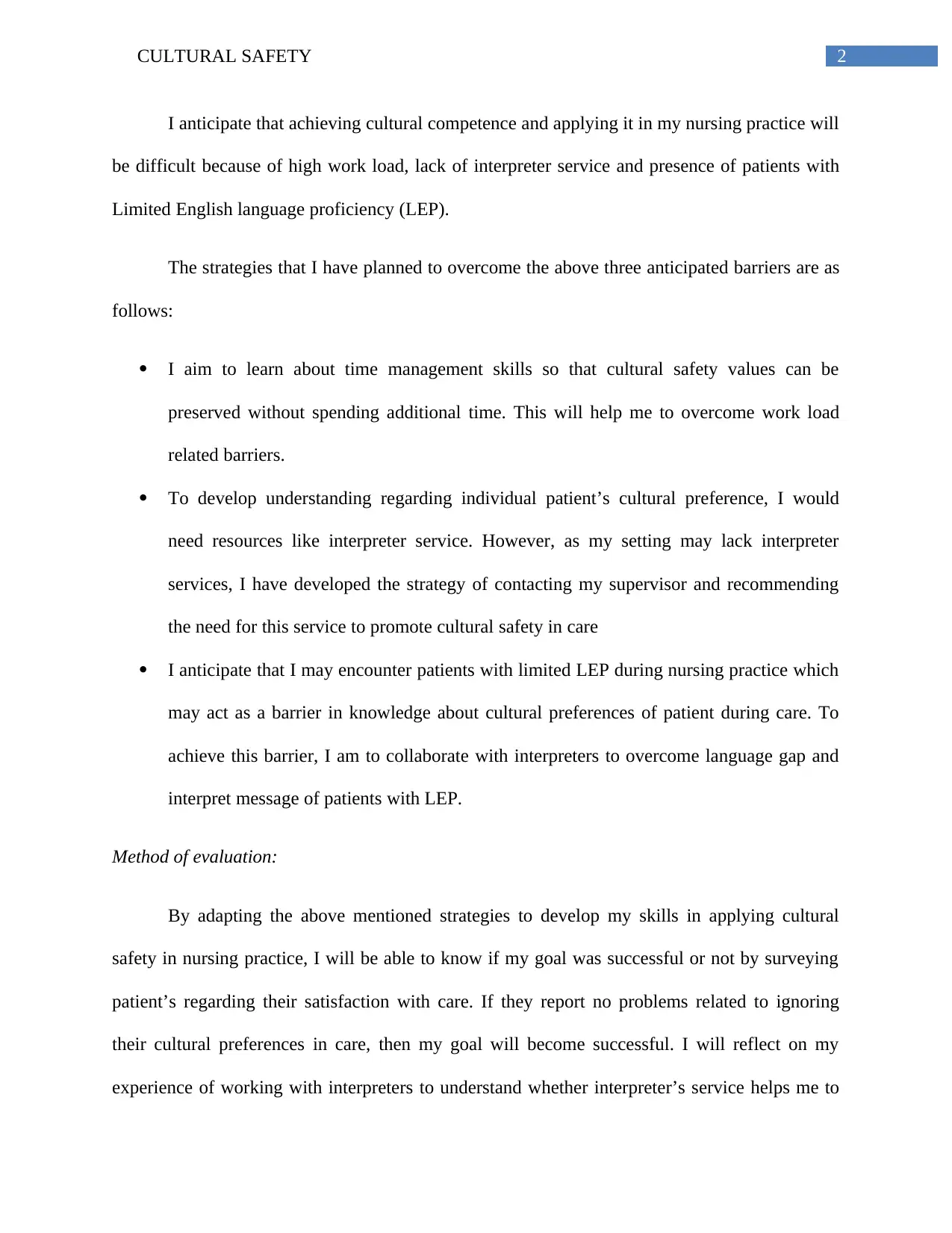
2CULTURAL SAFETY
I anticipate that achieving cultural competence and applying it in my nursing practice will
be difficult because of high work load, lack of interpreter service and presence of patients with
Limited English language proficiency (LEP).
The strategies that I have planned to overcome the above three anticipated barriers are as
follows:
I aim to learn about time management skills so that cultural safety values can be
preserved without spending additional time. This will help me to overcome work load
related barriers.
To develop understanding regarding individual patient’s cultural preference, I would
need resources like interpreter service. However, as my setting may lack interpreter
services, I have developed the strategy of contacting my supervisor and recommending
the need for this service to promote cultural safety in care
I anticipate that I may encounter patients with limited LEP during nursing practice which
may act as a barrier in knowledge about cultural preferences of patient during care. To
achieve this barrier, I am to collaborate with interpreters to overcome language gap and
interpret message of patients with LEP.
Method of evaluation:
By adapting the above mentioned strategies to develop my skills in applying cultural
safety in nursing practice, I will be able to know if my goal was successful or not by surveying
patient’s regarding their satisfaction with care. If they report no problems related to ignoring
their cultural preferences in care, then my goal will become successful. I will reflect on my
experience of working with interpreters to understand whether interpreter’s service helps me to
I anticipate that achieving cultural competence and applying it in my nursing practice will
be difficult because of high work load, lack of interpreter service and presence of patients with
Limited English language proficiency (LEP).
The strategies that I have planned to overcome the above three anticipated barriers are as
follows:
I aim to learn about time management skills so that cultural safety values can be
preserved without spending additional time. This will help me to overcome work load
related barriers.
To develop understanding regarding individual patient’s cultural preference, I would
need resources like interpreter service. However, as my setting may lack interpreter
services, I have developed the strategy of contacting my supervisor and recommending
the need for this service to promote cultural safety in care
I anticipate that I may encounter patients with limited LEP during nursing practice which
may act as a barrier in knowledge about cultural preferences of patient during care. To
achieve this barrier, I am to collaborate with interpreters to overcome language gap and
interpret message of patients with LEP.
Method of evaluation:
By adapting the above mentioned strategies to develop my skills in applying cultural
safety in nursing practice, I will be able to know if my goal was successful or not by surveying
patient’s regarding their satisfaction with care. If they report no problems related to ignoring
their cultural preferences in care, then my goal will become successful. I will reflect on my
experience of working with interpreters to understand whether interpreter’s service helps me to
⊘ This is a preview!⊘
Do you want full access?
Subscribe today to unlock all pages.

Trusted by 1+ million students worldwide

3CULTURAL SAFETY
fulfil the objectives of cultural safety or not. I think my ideas will be received well because I am
displaying commitment towards professional development by taking part in training. Beside this,
I am also recommending need for organization support so that I can get interpreters who will
support me in achieving my objectives. My cultural safety plan might help to initiate interpreter
service in my organization and deliver care with the collaboration with interpreters.
Part two: Written rationale for the personal action plan
Need for such plan:
Person action plan related to cultural safety has emerged because of the importance of
cultural safety culture on patient outcome and patient’s satisfaction with care. It works to reduce
disparities in care and prevent violation of cultural values of patients during care. Hence, having
cultural competence skill is a demand for health care professionals and making endeavours in
this area is vital for achieving the unique demands and quality improvement goals of health care
organization (Holland, 2017). Almutairi (2015) argues that effective communication with patient
and health care professional is essential for providing safe and quality health care and effective
communication takes place when care is responsive to patient’s need. However, certain factors
like low health literacy, cultural differences and language barriers creates cultural
misunderstanding between nurse and patient and lead to poor quality of care. It is also associated
with patient dissatisfaction. Hence, prevalence of cultural differences and violation of patient’s
preference because of poor cultural knowledge also suggest the need for developing such cultural
safety action plan. My efforts and commitment in this area will help me to reduce patient’s
dissatisfaction with care and achieve the principles of patient-centred care and cultural safety.
fulfil the objectives of cultural safety or not. I think my ideas will be received well because I am
displaying commitment towards professional development by taking part in training. Beside this,
I am also recommending need for organization support so that I can get interpreters who will
support me in achieving my objectives. My cultural safety plan might help to initiate interpreter
service in my organization and deliver care with the collaboration with interpreters.
Part two: Written rationale for the personal action plan
Need for such plan:
Person action plan related to cultural safety has emerged because of the importance of
cultural safety culture on patient outcome and patient’s satisfaction with care. It works to reduce
disparities in care and prevent violation of cultural values of patients during care. Hence, having
cultural competence skill is a demand for health care professionals and making endeavours in
this area is vital for achieving the unique demands and quality improvement goals of health care
organization (Holland, 2017). Almutairi (2015) argues that effective communication with patient
and health care professional is essential for providing safe and quality health care and effective
communication takes place when care is responsive to patient’s need. However, certain factors
like low health literacy, cultural differences and language barriers creates cultural
misunderstanding between nurse and patient and lead to poor quality of care. It is also associated
with patient dissatisfaction. Hence, prevalence of cultural differences and violation of patient’s
preference because of poor cultural knowledge also suggest the need for developing such cultural
safety action plan. My efforts and commitment in this area will help me to reduce patient’s
dissatisfaction with care and achieve the principles of patient-centred care and cultural safety.
Paraphrase This Document
Need a fresh take? Get an instant paraphrase of this document with our AI Paraphraser
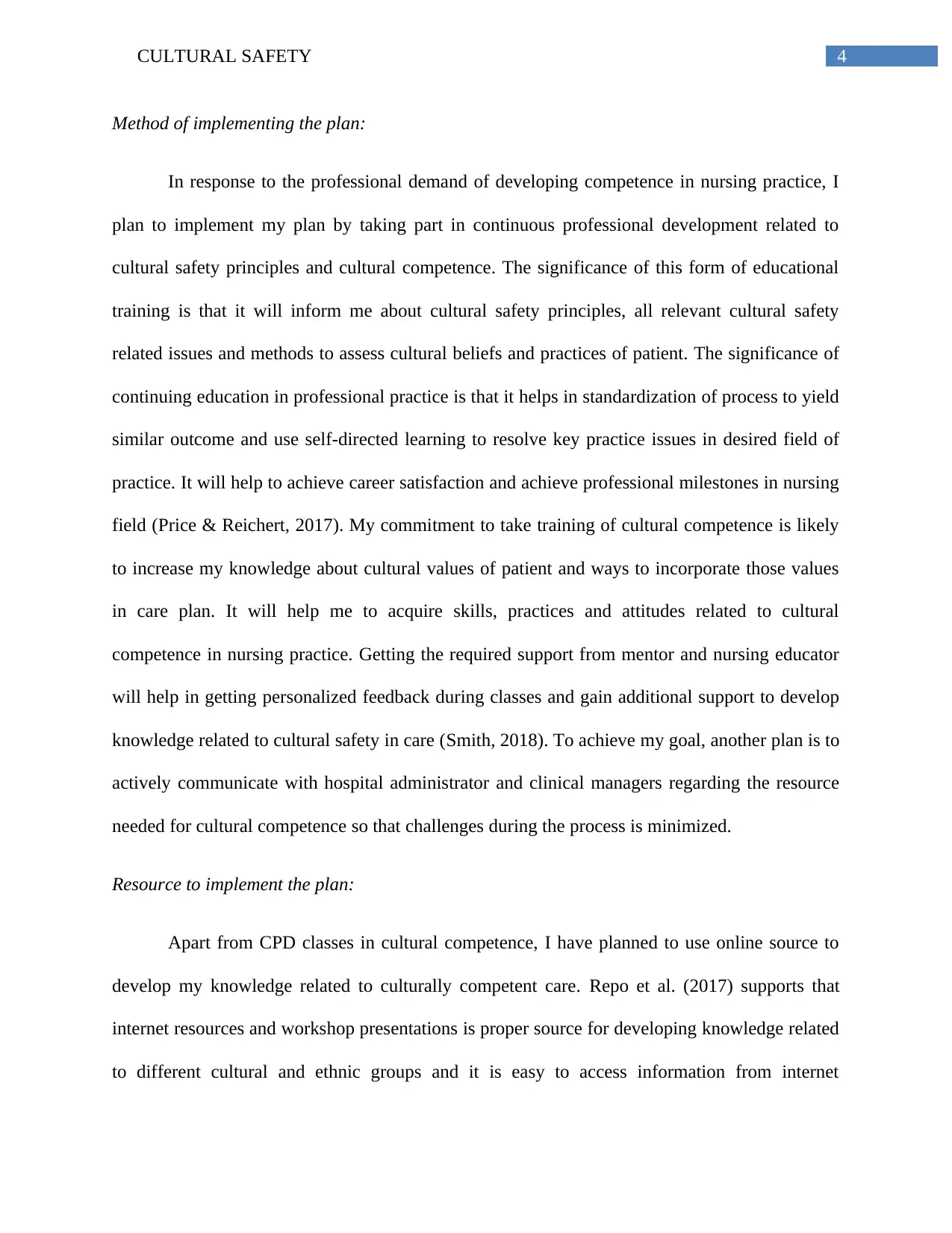
4CULTURAL SAFETY
Method of implementing the plan:
In response to the professional demand of developing competence in nursing practice, I
plan to implement my plan by taking part in continuous professional development related to
cultural safety principles and cultural competence. The significance of this form of educational
training is that it will inform me about cultural safety principles, all relevant cultural safety
related issues and methods to assess cultural beliefs and practices of patient. The significance of
continuing education in professional practice is that it helps in standardization of process to yield
similar outcome and use self-directed learning to resolve key practice issues in desired field of
practice. It will help to achieve career satisfaction and achieve professional milestones in nursing
field (Price & Reichert, 2017). My commitment to take training of cultural competence is likely
to increase my knowledge about cultural values of patient and ways to incorporate those values
in care plan. It will help me to acquire skills, practices and attitudes related to cultural
competence in nursing practice. Getting the required support from mentor and nursing educator
will help in getting personalized feedback during classes and gain additional support to develop
knowledge related to cultural safety in care (Smith, 2018). To achieve my goal, another plan is to
actively communicate with hospital administrator and clinical managers regarding the resource
needed for cultural competence so that challenges during the process is minimized.
Resource to implement the plan:
Apart from CPD classes in cultural competence, I have planned to use online source to
develop my knowledge related to culturally competent care. Repo et al. (2017) supports that
internet resources and workshop presentations is proper source for developing knowledge related
to different cultural and ethnic groups and it is easy to access information from internet
Method of implementing the plan:
In response to the professional demand of developing competence in nursing practice, I
plan to implement my plan by taking part in continuous professional development related to
cultural safety principles and cultural competence. The significance of this form of educational
training is that it will inform me about cultural safety principles, all relevant cultural safety
related issues and methods to assess cultural beliefs and practices of patient. The significance of
continuing education in professional practice is that it helps in standardization of process to yield
similar outcome and use self-directed learning to resolve key practice issues in desired field of
practice. It will help to achieve career satisfaction and achieve professional milestones in nursing
field (Price & Reichert, 2017). My commitment to take training of cultural competence is likely
to increase my knowledge about cultural values of patient and ways to incorporate those values
in care plan. It will help me to acquire skills, practices and attitudes related to cultural
competence in nursing practice. Getting the required support from mentor and nursing educator
will help in getting personalized feedback during classes and gain additional support to develop
knowledge related to cultural safety in care (Smith, 2018). To achieve my goal, another plan is to
actively communicate with hospital administrator and clinical managers regarding the resource
needed for cultural competence so that challenges during the process is minimized.
Resource to implement the plan:
Apart from CPD classes in cultural competence, I have planned to use online source to
develop my knowledge related to culturally competent care. Repo et al. (2017) supports that
internet resources and workshop presentations is proper source for developing knowledge related
to different cultural and ethnic groups and it is easy to access information from internet
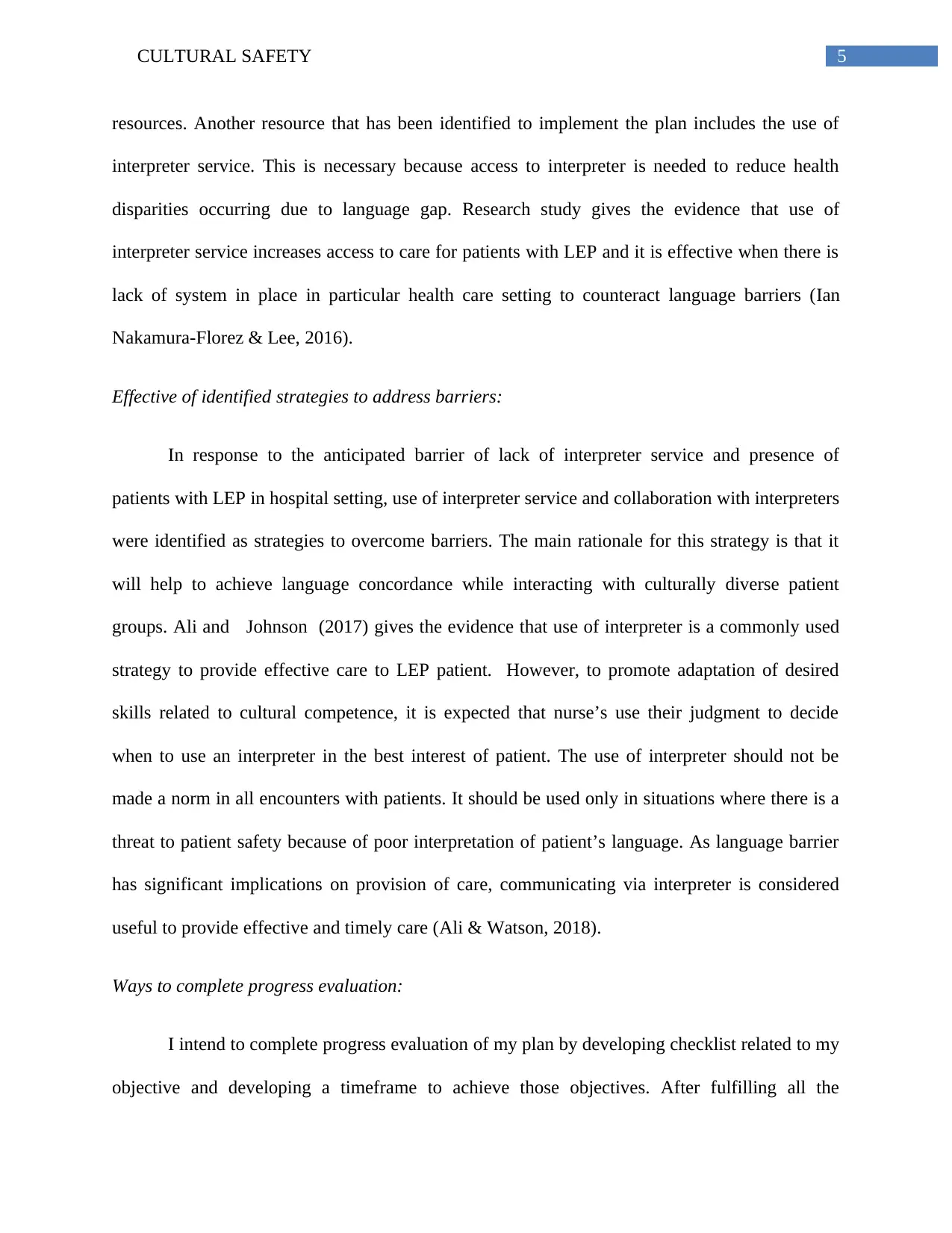
5CULTURAL SAFETY
resources. Another resource that has been identified to implement the plan includes the use of
interpreter service. This is necessary because access to interpreter is needed to reduce health
disparities occurring due to language gap. Research study gives the evidence that use of
interpreter service increases access to care for patients with LEP and it is effective when there is
lack of system in place in particular health care setting to counteract language barriers (Ian
Nakamura-Florez & Lee, 2016).
Effective of identified strategies to address barriers:
In response to the anticipated barrier of lack of interpreter service and presence of
patients with LEP in hospital setting, use of interpreter service and collaboration with interpreters
were identified as strategies to overcome barriers. The main rationale for this strategy is that it
will help to achieve language concordance while interacting with culturally diverse patient
groups. Ali and Johnson (2017) gives the evidence that use of interpreter is a commonly used
strategy to provide effective care to LEP patient. However, to promote adaptation of desired
skills related to cultural competence, it is expected that nurse’s use their judgment to decide
when to use an interpreter in the best interest of patient. The use of interpreter should not be
made a norm in all encounters with patients. It should be used only in situations where there is a
threat to patient safety because of poor interpretation of patient’s language. As language barrier
has significant implications on provision of care, communicating via interpreter is considered
useful to provide effective and timely care (Ali & Watson, 2018).
Ways to complete progress evaluation:
I intend to complete progress evaluation of my plan by developing checklist related to my
objective and developing a timeframe to achieve those objectives. After fulfilling all the
resources. Another resource that has been identified to implement the plan includes the use of
interpreter service. This is necessary because access to interpreter is needed to reduce health
disparities occurring due to language gap. Research study gives the evidence that use of
interpreter service increases access to care for patients with LEP and it is effective when there is
lack of system in place in particular health care setting to counteract language barriers (Ian
Nakamura-Florez & Lee, 2016).
Effective of identified strategies to address barriers:
In response to the anticipated barrier of lack of interpreter service and presence of
patients with LEP in hospital setting, use of interpreter service and collaboration with interpreters
were identified as strategies to overcome barriers. The main rationale for this strategy is that it
will help to achieve language concordance while interacting with culturally diverse patient
groups. Ali and Johnson (2017) gives the evidence that use of interpreter is a commonly used
strategy to provide effective care to LEP patient. However, to promote adaptation of desired
skills related to cultural competence, it is expected that nurse’s use their judgment to decide
when to use an interpreter in the best interest of patient. The use of interpreter should not be
made a norm in all encounters with patients. It should be used only in situations where there is a
threat to patient safety because of poor interpretation of patient’s language. As language barrier
has significant implications on provision of care, communicating via interpreter is considered
useful to provide effective and timely care (Ali & Watson, 2018).
Ways to complete progress evaluation:
I intend to complete progress evaluation of my plan by developing checklist related to my
objective and developing a timeframe to achieve those objectives. After fulfilling all the
⊘ This is a preview!⊘
Do you want full access?
Subscribe today to unlock all pages.

Trusted by 1+ million students worldwide
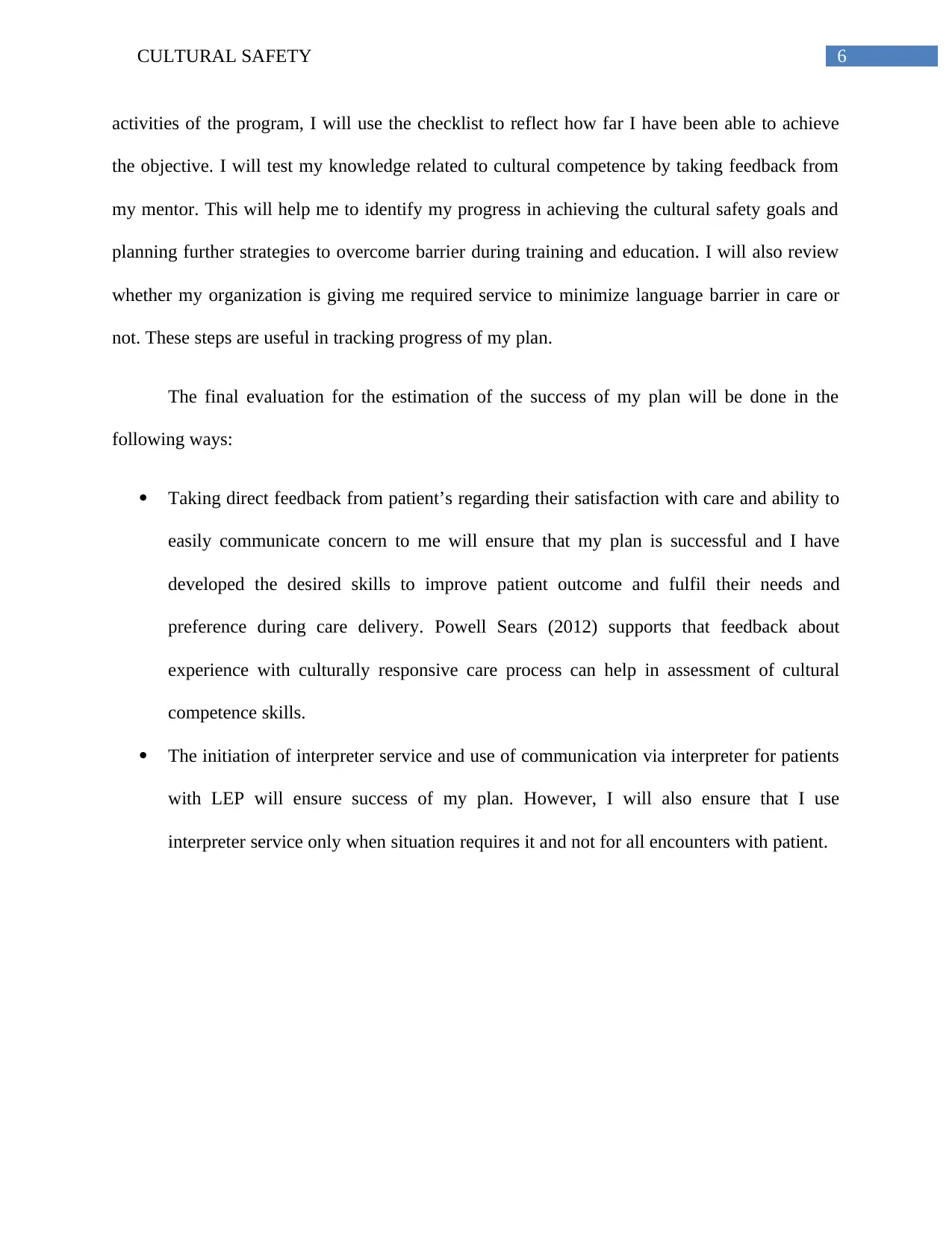
6CULTURAL SAFETY
activities of the program, I will use the checklist to reflect how far I have been able to achieve
the objective. I will test my knowledge related to cultural competence by taking feedback from
my mentor. This will help me to identify my progress in achieving the cultural safety goals and
planning further strategies to overcome barrier during training and education. I will also review
whether my organization is giving me required service to minimize language barrier in care or
not. These steps are useful in tracking progress of my plan.
The final evaluation for the estimation of the success of my plan will be done in the
following ways:
Taking direct feedback from patient’s regarding their satisfaction with care and ability to
easily communicate concern to me will ensure that my plan is successful and I have
developed the desired skills to improve patient outcome and fulfil their needs and
preference during care delivery. Powell Sears (2012) supports that feedback about
experience with culturally responsive care process can help in assessment of cultural
competence skills.
The initiation of interpreter service and use of communication via interpreter for patients
with LEP will ensure success of my plan. However, I will also ensure that I use
interpreter service only when situation requires it and not for all encounters with patient.
activities of the program, I will use the checklist to reflect how far I have been able to achieve
the objective. I will test my knowledge related to cultural competence by taking feedback from
my mentor. This will help me to identify my progress in achieving the cultural safety goals and
planning further strategies to overcome barrier during training and education. I will also review
whether my organization is giving me required service to minimize language barrier in care or
not. These steps are useful in tracking progress of my plan.
The final evaluation for the estimation of the success of my plan will be done in the
following ways:
Taking direct feedback from patient’s regarding their satisfaction with care and ability to
easily communicate concern to me will ensure that my plan is successful and I have
developed the desired skills to improve patient outcome and fulfil their needs and
preference during care delivery. Powell Sears (2012) supports that feedback about
experience with culturally responsive care process can help in assessment of cultural
competence skills.
The initiation of interpreter service and use of communication via interpreter for patients
with LEP will ensure success of my plan. However, I will also ensure that I use
interpreter service only when situation requires it and not for all encounters with patient.
Paraphrase This Document
Need a fresh take? Get an instant paraphrase of this document with our AI Paraphraser

7CULTURAL SAFETY
References:
Ali, P. A., & Johnson, S. (2017). Speaking my patient's language: bilingual nurses’ perspective
about provision of language concordant care to patients with limited English
proficiency. Journal of advanced nursing, 73(2), 421-432.
Ali, P. A., & Watson, R. (2018). Language barriers and their impact on provision of care to
patients with limited English proficiency: Nurses' perspectives. Journal of clinical
nursing, 27(5-6), e1152-e1160.
Almutairi, K. M. (2015). Culture and language differences as a barrier to provision of quality
care by the health workforce in Saudi Arabia. Saudi medical journal, 36(4), 425.
Holland, K. (2017). Cultural awareness in nursing and health care: an introductory text.
Routledge.
Ian, C., Nakamura-Florez, E., & Lee, Y. M. (2016). Registered nurses' experiences with caring
for non-English speaking patients. Applied nursing research, 30, 257-260.
Powell Sears, K. (2012). Improving cultural competence education: the utility of an
intersectional framework. Medical education, 46(6), 545-551.
Price, S., & Reichert, C. (2017). The importance of continuing professional development to
career satisfaction and patient care: meeting the needs of novice to mid-to late-career
nurses throughout their career span. Administrative Sciences, 7(2), 17.
Repo, H., Vahlberg, T., Salminen, L., Papadopoulos, I., & Leino-Kilpi, H. (2017). The cultural
competence of graduating nursing students. Journal of transcultural nursing, 28(1), 98-
107.
References:
Ali, P. A., & Johnson, S. (2017). Speaking my patient's language: bilingual nurses’ perspective
about provision of language concordant care to patients with limited English
proficiency. Journal of advanced nursing, 73(2), 421-432.
Ali, P. A., & Watson, R. (2018). Language barriers and their impact on provision of care to
patients with limited English proficiency: Nurses' perspectives. Journal of clinical
nursing, 27(5-6), e1152-e1160.
Almutairi, K. M. (2015). Culture and language differences as a barrier to provision of quality
care by the health workforce in Saudi Arabia. Saudi medical journal, 36(4), 425.
Holland, K. (2017). Cultural awareness in nursing and health care: an introductory text.
Routledge.
Ian, C., Nakamura-Florez, E., & Lee, Y. M. (2016). Registered nurses' experiences with caring
for non-English speaking patients. Applied nursing research, 30, 257-260.
Powell Sears, K. (2012). Improving cultural competence education: the utility of an
intersectional framework. Medical education, 46(6), 545-551.
Price, S., & Reichert, C. (2017). The importance of continuing professional development to
career satisfaction and patient care: meeting the needs of novice to mid-to late-career
nurses throughout their career span. Administrative Sciences, 7(2), 17.
Repo, H., Vahlberg, T., Salminen, L., Papadopoulos, I., & Leino-Kilpi, H. (2017). The cultural
competence of graduating nursing students. Journal of transcultural nursing, 28(1), 98-
107.
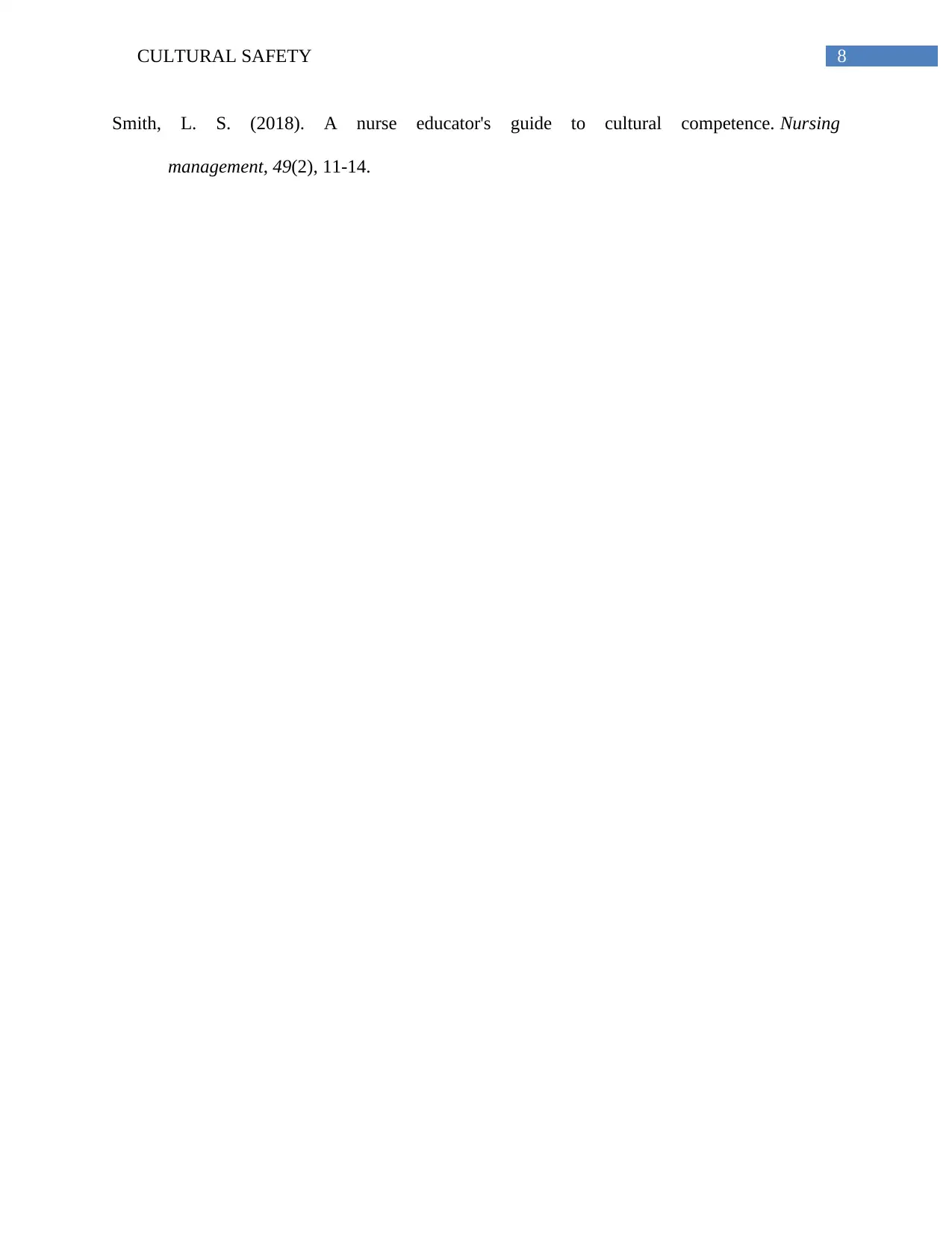
8CULTURAL SAFETY
Smith, L. S. (2018). A nurse educator's guide to cultural competence. Nursing
management, 49(2), 11-14.
Smith, L. S. (2018). A nurse educator's guide to cultural competence. Nursing
management, 49(2), 11-14.
⊘ This is a preview!⊘
Do you want full access?
Subscribe today to unlock all pages.

Trusted by 1+ million students worldwide
1 out of 9
Related Documents
Your All-in-One AI-Powered Toolkit for Academic Success.
+13062052269
info@desklib.com
Available 24*7 on WhatsApp / Email
![[object Object]](/_next/static/media/star-bottom.7253800d.svg)
Unlock your academic potential
Copyright © 2020–2025 A2Z Services. All Rights Reserved. Developed and managed by ZUCOL.




